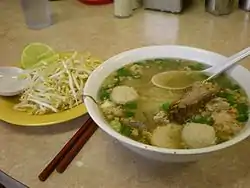Kuy teav
Kuy teav or kway teow (Khmer: គុយទាវ) is a Cambodian noodle soup consisting of rice noodles with pork stock and toppings. A popular breakfast dish in Cambodia, kuy teav can be found at marketplace (phsar) stalls, roadside vendors, restaurants and in shophouses across the country, and is distinguished by its clear broth and array of herbs, aromatics and other garnishes and condiments.
 Kuy teav as served in a restaurant | |
| Course | Breakfast, lunch, or dinner |
|---|---|
| Place of origin | Cambodia |
| Region or state | Southeast Asia |
| Associated national cuisine | Cambodia |
| Main ingredients | Rice noodles, pork stock |
| Similar dishes | Hủ tiếu, Kyay oh |
Etymology
The word kway teow derives from the Teochew Chinese word 粿條 (peng'im: guê2diao5) and refers to cut noodles made from long-grain rice flour (as opposed to glutinous rice flour).[1] This term also refers to the dish: a rice noodle soup with minced meat and various other toppings and seasonings.[1] In Khmer, kuy teav is properly pronounced IPA: [kuj t̪ieʋ] but is often elided to IPA: [kə t̪ieʋ] (romanized as k'tieu, katieu, kateav, etc.) due to the sesquisyllabic nature of the Khmer language. The term has cognates in Southeast Asia with hủ tiếu in Vietnamese,[2] kway teow in Malaysia and Singapore, and kuai tiao (ก๋วยเตี๋ยว) in Thai being analogues.
Preparation
Kuy teav is prepared with partially dry thin squarish rice noodles cooked by quickly immersing the noodles in boiling water. The noodles are then strained, placed into a bowl, and moistened with nutty, caramelised garlic oil. After dressing with a sticky brown liquid made of oyster sauce, soy sauce and a pinch of sugar, the bowl is then filled with a clear broth made from pork bones, dried squid, and sugar, and seasoned with a bit of fish sauce. Then the meat toppings are added, which may include an assembly of different types of meat, such as pork loaf, minced pork, pork belly, duck, seafood or offal. Availability is the main factor in what toppings are used in kuy teav; some versions can be quite humble and basic, using only some ground pork and perhaps some dried shrimp for protein, while others can be more time-consuming and extravagant. Finally, when the dish is presented at the table, the diner may add a number of garnishes and aromatics to customise the dish in accordance with his or her preferences.
Moreover, kuy teav may be presented in one of two ways: with all the ingredients in the soup, or with the soup on the side. Both versions can have exactly the same ingredients but allow the diner to control the balance of flavours, spiciness and textures. When the dish is served this way (“dry” as opposed to “wet”) the dish takes on the appearance of a noodle salad. Finally, the Phnom Penh version of kuy teav is the most extravagant and features the most embellishments, owing to the city's historical wealth and importance. Kuy teav Phnom Penh may contain some or all of the following toppings: sliced pork belly, ground pork, pig's blood jelly, chopped pork offal (such as intestine, heart, liver and lung), roast duck, Mekong River prawns, sliced fish cake and squid.
Consumption and culture
In Cambodia, kuy teav is still primarily a breakfast dish, and will typically be sold out by vendors before midday. As the pork broth is intended to be subtle rather than spicy, a plethora of optional herbs and other aromatics is always presented, allowing the diner to adjust the textures and flavours of the dish to his or her liking. In fact, in Cambodia it is precisely the use of garnishes and condiments that defines the main flavour profile of the dish (garlic, limes and pepper are a common flavour trio in Cambodian cuisine), rather than the broth. The dish is served with garnishes that can include lettuce leaves, bean sprouts, fresh herbs (such as spring onions (scallions), sawtooth coriander and holy basil), crushed black kampot pepper, lime juice, and caramelised garlic oil. Many types of chilli (fresh, dried, pickled) and chilli sauce are also normally present at the table, to either add into the broth or to be used as a dipping sauce for the meat toppings, as well as soy sauce, fish sauce and sugar. Kuy teav is also sometimes eaten with deep fried breadsticks, similar to how the Cambodians would eat congee (rice porridge).
Kuy teav spread to Vietnam under the name Hủ tiếu Nam Vang ("Phnom Penh kuy teav").[3]

References
- Nath, Chuon. Khmer-Khmer Dictionary. Buddhist Institute of Cambodia, 1967
- "Hai tiếng "hủ tíu" có phải do tiếng Quảng Đông mà ra?" [Does the compound word “hủ tíu” come from Cantonese?]. Hồn Việt (in Vietnamese). Ho Chi Minh City. September 14, 2010. Retrieved July 16, 2018.
- Nguyen, Andrea. "Hu tieu lowdown: The Chinese-Vietnamese-Cambodian noodles you need to know better". Los Angeles Times. Retrieved 15 January 2021.
- Cambodia: Daily life and social customs. Britannica Online Encyclopedia. Rpt. in Cambodia. N.p.: n.p., n.d. N. pag. Encyclopædia Britannica Online. Web. 15 May 2010.
.jpg.webp)